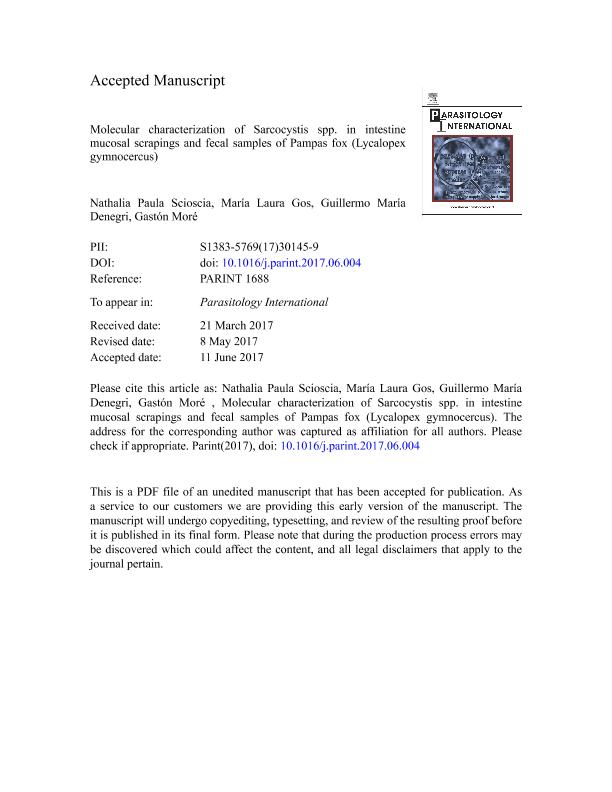Mostrar el registro sencillo del ítem
dc.contributor.author
Scioscia, Nathalia Paula

dc.contributor.author
Gos, Maria Laura

dc.contributor.author
Denegri, Guillermo Maria

dc.contributor.author
Moré, Gastón Andrés

dc.date.available
2018-06-25T16:04:50Z
dc.date.issued
2017-10
dc.identifier.citation
Scioscia, Nathalia Paula; Gos, Maria Laura; Denegri, Guillermo Maria; Moré, Gastón Andrés; Molecular characterization of Sarcocystis spp. in intestine mucosal scrapings and fecal samples of Pampas fox (Lycalopex gymnocercus); Elsevier Ireland; Parasitology International; 66; 5; 10-2017; 622-626
dc.identifier.issn
1383-5769
dc.identifier.uri
http://hdl.handle.net/11336/49928
dc.description.abstract
Sarcocystis spp. are obligatory intracellular protozoan parasites which can infect humans and animals. Most of Sarcocystis species were identified based on the detection of muscle cysts in different intermediate hosts (IH). Regarding to natural infection in definitive host, there are few reports which have reached to determining species of Sarcocystis. The present work was aimed to studying the occurrence of Sarcocystis spp. (oocysts and sporocysts) in mucosal scrapings of small intestine and fecal samples of one the most abundant wild canids from South America, Lycalopex gymnocercus (Pampas fox), and to identify the Sarcocystis spp. using molecular tools. A total of 131 free-living L. gymnocercus were sampled in rural areas located in several departments from Buenos Aires province, Argentina. Fecal samples from all the animals and 33 small intestines were analyzed. Fecal and mucosal scrapings samples were analyzed by sugar flotation method and once oocysts or sporocysts were detected, sedimentation was performed and DNA extracted with a commercial kit. A PCR was conducted using primers targeting a fragment of the 18S rRNA gene and the amplicons were purified and sequenced. Of the total Pampas foxes analyzed, 23 (17.6%) had Sarcocystis spp. oocysts/sporocysts in fecal and/or mucosal samples. Sarcocystis spp. sporocysts were detected in 13.0% (17/131) of fecal samples and in 39.4% (13/33) of mucosal samples by the initial sugar flotation. Twenty one L. gymnocercus samples were processed by DNA extraction and PCR. Molecular identification of Sarcocystis spp. infection was successfully achieved in 14 foxes and was distributed as follows: 4.6% S. cruzi (6/131), 3.8% Sarcocystis spp. using birds as IH (S. albifronsi and S. anasi among others, 5/131), 0.8% S. tenella (1/131) and 1.5% (2/131) with low homology (97%) with S. miescheriana. In one fecal sample with spherical oocysts, the sequencing results showed a 100% sequence identity with Hammondia heydorni. The results show that the mucosal scrapings are the eligible sample to identify prevalence and to proceed with species identification. Lycalopex gymnocercus is suggested as definitive host for S. cruzi, S. tenella and probably various Sarcocystis spp. using birds as intermediate hosts as well as for H. heydorni.
dc.format
application/pdf
dc.language.iso
eng
dc.publisher
Elsevier Ireland

dc.rights
info:eu-repo/semantics/openAccess
dc.rights.uri
https://creativecommons.org/licenses/by-nc-nd/2.5/ar/
dc.subject
Definitive Host
dc.subject
Fecal Samples
dc.subject
Mucosal Scraping
dc.subject
Sarcocystis Spp.
dc.subject
Sequencing
dc.subject
Wild Canid
dc.subject.classification
Otras Ciencias Biológicas

dc.subject.classification
Ciencias Biológicas

dc.subject.classification
CIENCIAS NATURALES Y EXACTAS

dc.title
Molecular characterization of Sarcocystis spp. in intestine mucosal scrapings and fecal samples of Pampas fox (Lycalopex gymnocercus)
dc.type
info:eu-repo/semantics/article
dc.type
info:ar-repo/semantics/artículo
dc.type
info:eu-repo/semantics/publishedVersion
dc.date.updated
2018-06-22T15:03:03Z
dc.journal.volume
66
dc.journal.number
5
dc.journal.pagination
622-626
dc.journal.pais
Irlanda

dc.journal.ciudad
Shannon
dc.description.fil
Fil: Scioscia, Nathalia Paula. Consejo Nacional de Investigaciones Científicas y Técnicas; Argentina. Universidad Nacional de Mar del Plata. Facultad de Ciencias Exactas y Naturales; Argentina
dc.description.fil
Fil: Gos, Maria Laura. Consejo Nacional de Investigaciones Científicas y Técnicas. Centro Científico Tecnológico Conicet - La Plata; Argentina. Universidad Nacional de La Plata. Facultad de Ciencias Veterinarias. Departamento de Epizootiología y Salud Pública. Laboratorio de Inmunoparasitología; Argentina
dc.description.fil
Fil: Denegri, Guillermo Maria. Consejo Nacional de Investigaciones Científicas y Técnicas; Argentina. Universidad Nacional de Mar del Plata. Facultad de Ciencias Exactas y Naturales; Argentina
dc.description.fil
Fil: Moré, Gastón Andrés. Consejo Nacional de Investigaciones Científicas y Técnicas. Centro Científico Tecnológico Conicet - La Plata; Argentina. Universidad Nacional de La Plata. Facultad de Ciencias Veterinarias. Departamento de Epizootiología y Salud Pública. Laboratorio de Inmunoparasitología; Argentina
dc.journal.title
Parasitology International

dc.relation.alternativeid
info:eu-repo/semantics/altIdentifier/doi/http://dx.doi.org/10.1016/j.parint.2017.06.004
dc.relation.alternativeid
info:eu-repo/semantics/altIdentifier/url/https://www.sciencedirect.com/science/article/pii/S1383576917301459
Archivos asociados
